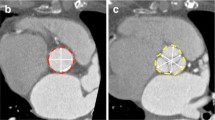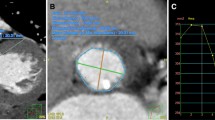Abstract
Background
Accurate assessment of the aortic annulus is crucial for successful transcatheter aortic valve replacement (TAVR), in particular to prevent paravalvular regurgitation (PVR). We compared aortic annular sizing using multidetector computed tomography (MDCT) and three-dimensional transoesophageal echocardiography (3-D TEE) to determine the predictive value of MDCT.
Methods and results
All patients admitted for transfemoral TAVR [n = 227; 48.9% balloon expandable (Edwards Sapien 3); 51.1% self-expandable (Core Valve, Evolut R)] at our institution from January 2015 until December 2016 were analysed retrospectively. Aortic annular parameters were obtained either by MDCT or 3-D TEE. Additionally, we included a cohort of patients (n = 27) assessed by both MDCT and 3D TEE between October 2017 and April 2018 to enable intra-individual comparison of the two methods. Indications for TAVR were severe degenerative aortic stenosis (AS; 94.7%) or re-stenosis after surgical AVR (5.3%). 74.4% were classified as high-gradient AS. The mean age was 80 (37–94) years and 75.8% presented with NYHA III/IV. STS risk of mortality was intermediate (3.5 ± 2.3). MDCT and 3-D TEE were performed in 116 and 111 patients for aortic annulus sizing, respectively. Significantly larger implants were chosen in the CT group irrespective of prosthesis type or post-dilatation. Follow-up (median at 79 days) revealed significantly less PVR in the MDCT compared to 3-D TEE group (absence of PVR in 59.3% and 40.7%, p = 0.016), without differences in mortality. Patients without PVR or mild PVR had a better clinical performance according to NYHA class (p = 0.016).
Conclusion
MDCT is superior to 3-D TEE in terms of sizing accuracy and clinical outcomes. Reduction of PVR after TAVR with MDCT is likely due to valve annulus undersizing by TEE.



Similar content being viewed by others
References
Leon MB et al (2010) Transcatheter aortic-valve implantation for aortic stenosis in patients who cannot undergo surgery. N Engl J Med 363(17):1597–1607
Leon MB et al (2016) Transcatheter or surgical aortic-valve replacement in intermediate-risk patients. N Engl J Med 374(17):1609–1620
Reardon MJ, Van Mieghem NM, Popma JJ (2017) Surgical or transcatheter aortic-valve replacement reply. N Engl J Med 377(2):197–198
Vahl TP, Kodali SK, Leon MB (2016) Transcatheter aortic valve replacement 2016 a modern-day “Through the Looking-Glass” adventure. J Am Coll Cardiol 67(12):1472–1487
Gaede L et al (2017) Trends in aortic valve replacement in Germany in 2015: transcatheter versus isolated surgical aortic valve repair. Clin Res Cardiol 106(6):411–419
Takagi H, Umemoto T, Grp A (2016) Impact of paravalvular aortic regurgitation after transcatheter aortic valve implantation on survival. Int J Cardiol 221:46–51
Kodali S et al (2015) Paravalvular regurgitation after transcatheter aortic valve replacement with the Edwards sapien valve in the PARTNER trial: characterizing patients and impact on outcomes. Eur Heart J 36(7):449–456
de Brito FS Jr et al (2015) Outcomes and predictors of mortality after transcatheter aortic valve implantation: results of the Brazilian registry. Catheter Cardiovasc Interv 85(5):E153–E162
Tamburino C et al (2011) Incidence and predictors of early and late mortality after transcatheter aortic valve implantation in 663 patients with severe aortic stenosis. Circulation 123(3):299–308
Bloomfield GS et al (2012) A practical guide to multimodality imaging of transcatheter aortic valve replacement. JACC Cardiovasc Imaging 5(4):441–455
Genereux P et al (2012) Transcatheter aortic valve implantation 10-year anniversary: review of current evidence and clinical implications. Eur Heart J 33(19):2388–2398
Willson AB et al (2012) 3-dimensional aortic annular assessment by multidetector computed tomography predicts moderate or severe paravalvular regurgitation after transcatheter aortic valve replacement: a multicenter retrospective analysis. J Am Coll Cardiol 59(14):1287–1294
Schultz CJ et al (2011) Correlates on MSCT of paravalvular aortic regurgitation after transcatheter aortic valve implantation using the Medtronic CoreValve prosthesis. Catheter Cardiovasc Interv 78(3):446–455
Achenbach S et al (2012) SCCT expert consensus document on computed tomography imaging before transcatheter aortic valve implantation (TAVI)/transcatheter aortic valve replacement (TAVR). J Cardiovasc Comput Tomogr 6(6):366–380
Khalique OK et al (2017) Impact of methodologic differences in three-dimensional echocardiographic measurements of the aortic annulus compared with computed tomographic angiography before transcatheter aortic valve replacement. J Am Soc Echocardiogr 30(4):414–421
Mylotte D et al (2014) Erroneous measurement of the aortic annular diameter using 2-dimensional echocardiography resulting in inappropriate CoreValve size selection: a retrospective comparison with multislice computed tomography. JACC Cardiovasc Interv 7(6):652–661
Jilaihawi H et al (2012) Cross-sectional computed tomographic assessment improves accuracy of aortic annular sizing for transcatheter aortic valve replacement and reduces the incidence of paravalvular aortic regurgitation. J Am Coll Cardiol 59(14):1275–1286
Baumgartner H et al (2017) 2017 ESC/EACTS Guidelines for the management of valvular heart disease. Eur Heart J 38(36):2739–2791
Baumgartner H et al (2017) 2017 ESC/EACTS guidelines for the management of valvular heart disease The Task Force for the Management of Valvular Heart Disease of the European Society of Cardiology (ESC) and the European Association for Cardio-Thoracic Surgery (EACTS). Eur Heart J 38(36):2739–2739+
Hahn RT et al (2013) Guidelines for performing a comprehensive transesophageal echocardiographic examination: recommendations from the American Society of Echocardiography and the Society of Cardiovascular Anesthesiologists. J Am Soc Echocardiogr 26(9):921–964
Kim WK et al (2016) Cyclic changes in area- and perimeter-derived effective dimensions of the aortic annulus measured with multislice computed tomography and comparison with metric intraoperative sizing. Clin Res Cardiol 105(7):622–629
Bleakley C, Eskandari M, Monaghan M (2017) 3D transoesophageal echocardiography in the TAVI sizing arena: should we do it and how do we do it? Echo Res Pract 4(1):R21–R32
Vaquerizo B et al (2016) Three-dimensional echocardiography vs. computed tomography for transcatheter aortic valve replacement sizing. Eur Heart J Cardiovasc Imaging 17(1):15–23
Detaint D et al (2009) Determinants of significant paravalvular regurgitation after transcatheter aortic valve: implantation impact of device and annulus discongruence. JACC Cardiovasc Interv 2(9):821–827
Ewe SH et al (2011) Location and severity of aortic valve calcium and implications for aortic regurgitation after transcatheter aortic valve implantation. Am J Cardiol 108(10):1470–1477
Mauri V et al (2018) Predictors of paravalvular regurgitation and permanent pacemaker implantation after TAVR with a next-generation self-expanding device. Clin Res Cardiol 107(8):688–697
Athappan G et al (2013) Incidence, predictors, and outcomes of aortic regurgitation after transcatheter aortic valve replacement: meta-analysis and systematic review of literature. J Am Coll Cardiol 61(15):1585–1595
Abdel-Wahab M et al (2011) Aortic regurgitation after transcatheter aortic valve implantation: incidence and early outcome. Results from the German transcatheter aortic valve interventions registry. Heart 97(11):899–906
Podlesnikar T et al (2018) Influence of the quantity of aortic valve calcium on the agreement between automated 3-dimensional transesophageal echocardiography and multidetector row computed tomography for aortic annulus sizing. Am J Cardiol 121(1):86–93
Kodali SK et al (2012) Two-year outcomes after transcatheter or surgical aortic-valve replacement. N Engl J Med 366(18):1686–1695
Sponga S et al (2012) Impact of residual regurgitation after aortic valve replacement. Eur J Cardiothorac Surg 42(3):486–492
Duncan BF et al (2015) Paravalvular regurgitation after conventional aortic and mitral valve replacement: a benchmark for alternative approaches. J Thorac Cardiovasc Surg 150(4):860–868
Raffa GM et al (2012) Aortic valve replacement for paraprosthetic leak after transcatheter implantation. J Card Surg 27(1):47–51
Zamorano JL et al (2011) EAE/ASE recommendations for the use of echocardiography in new transcatheter interventions for valvular heart disease. J Am Soc Echocardiogr 24(9):937–965
Kappetein AP et al (2013) Updated standardized endpoint definitions for transcatheter aortic valve implantation: the Valve Academic Research Consortium-2 consensus document. J Thorac Cardiovasc Surg 145(1):6–23
Acknowledgements
This work was supported by funding from the Foundation “Else Kröner-Fresenius-Stiftung”.
Author information
Authors and Affiliations
Corresponding author
Ethics declarations
Conflict of interest
The authors declare that they have no competing interests.
Rights and permissions
About this article
Cite this article
Wystub, N., Bäz, L., Möbius-Winkler, S. et al. Aortic annulus measurement with computed tomography angiography reduces aortic regurgitation after transfemoral aortic valve replacement compared to 3-D echocardiography: a single-centre experience. Clin Res Cardiol 108, 1266–1275 (2019). https://doi.org/10.1007/s00392-019-01462-6
Received:
Accepted:
Published:
Issue Date:
DOI: https://doi.org/10.1007/s00392-019-01462-6




